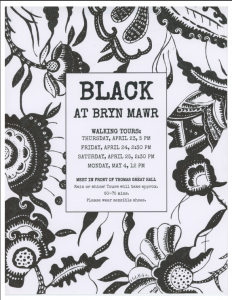The Greenfield Digital Center has been proud to support the work of Praxis III independent study students Emma Kioko ’15 and Grace Pusey ’15, whose semester-long project Black at Bryn Mawr includes a new walking tour of campus featuring their research. In February, Grace shared the origins of the project with readers, and since that time, they have presented their work-in-progress at Bryn Mawr’s Community Learning Day in March and at the Telling Untold Histories unconference earlier this month.
Emma and Grace will debut their walking tour on campus the week of April 21. For more details, see their blog, Black at Bryn Mawr. The project will also be featured at the final Friday Finds event of the semester, this Friday, April 24 from 4-5pm in Canaday 205 (Special Collections Seminar Room).
In May, Grace will debut the project’s digital component, a map of campus built on Google Open Tour Builder, at Women’s History in the Digital World 2015. Future project-related events will be featured on the Black at Bryn Mawr site.
